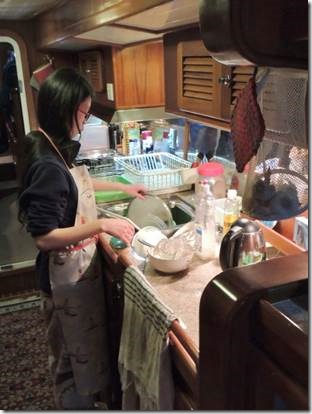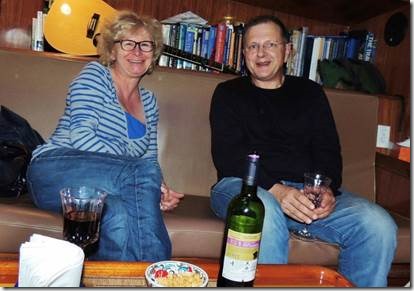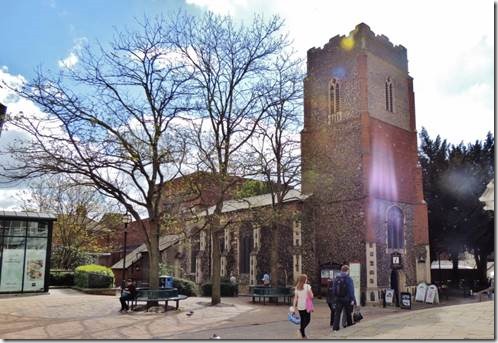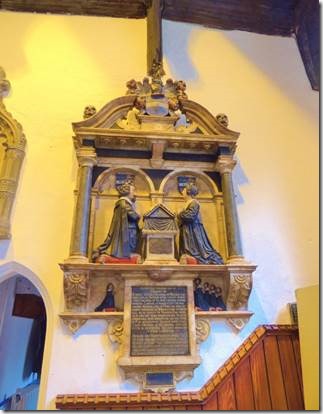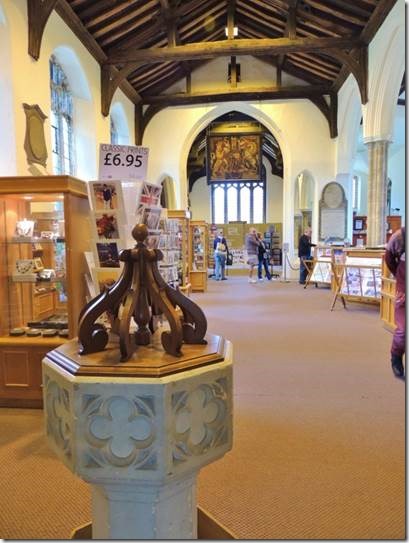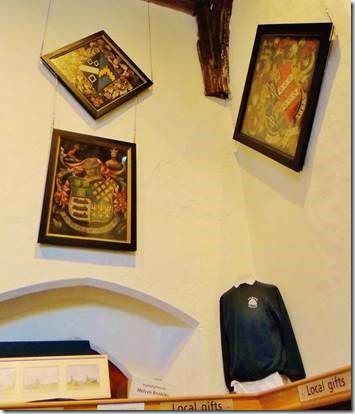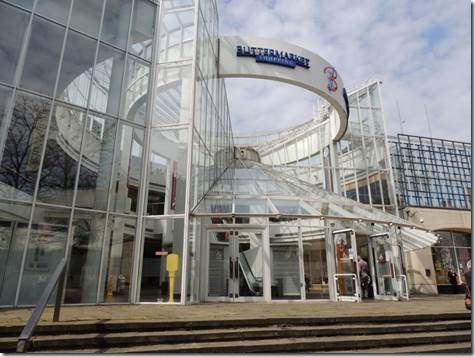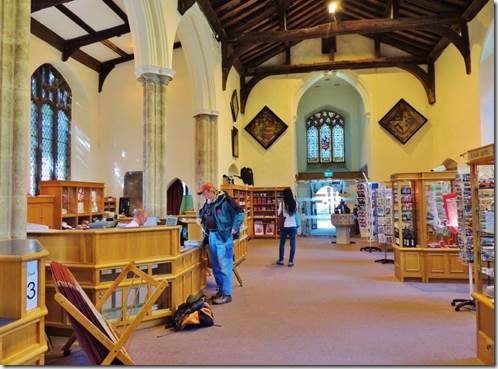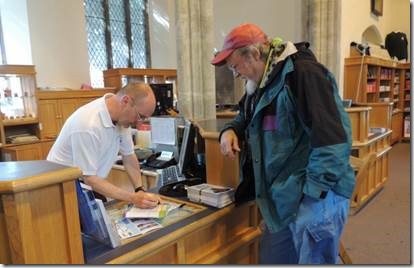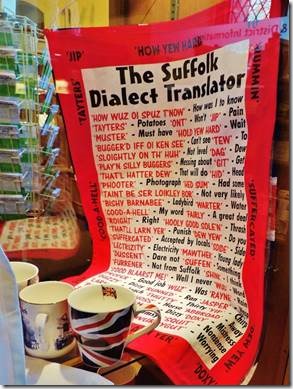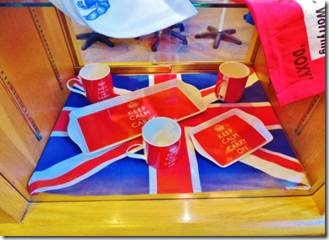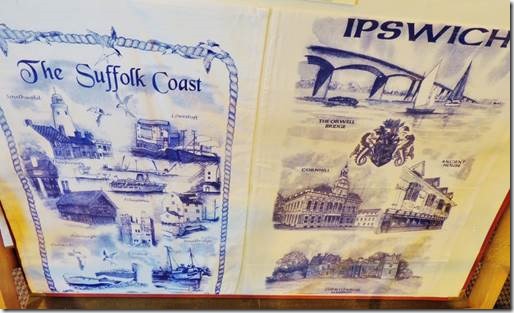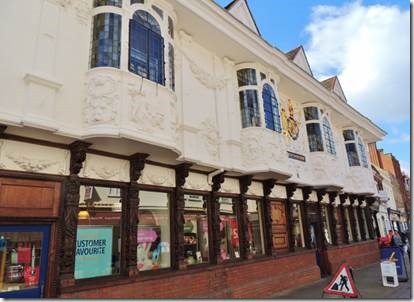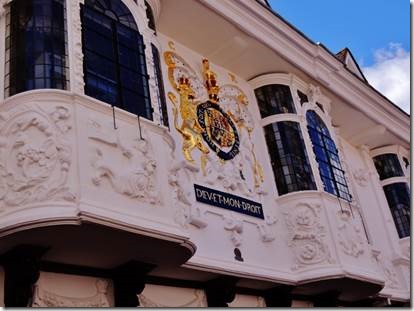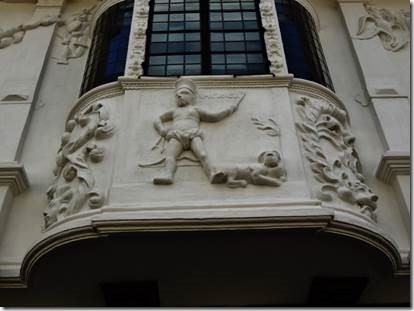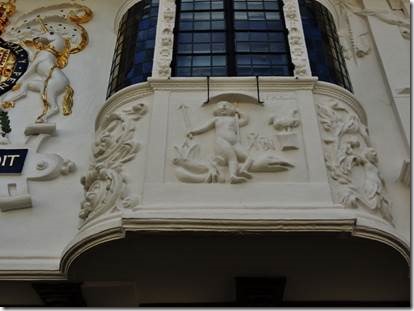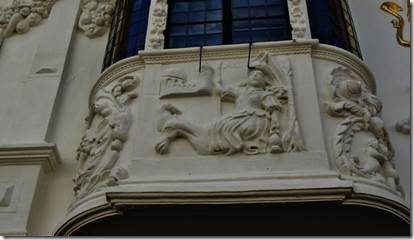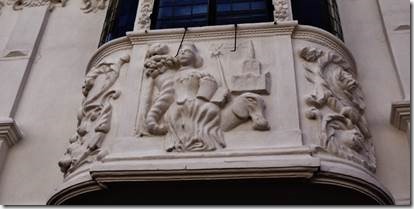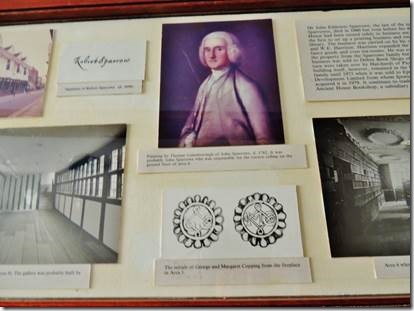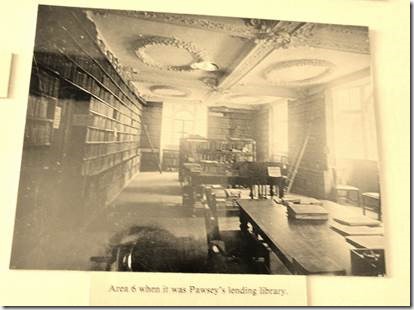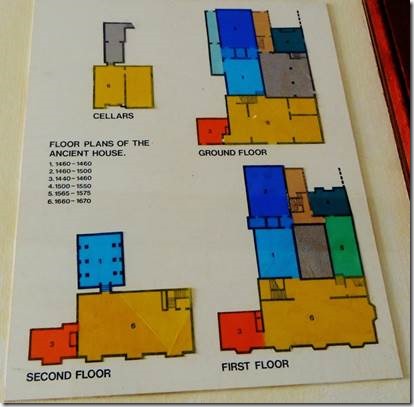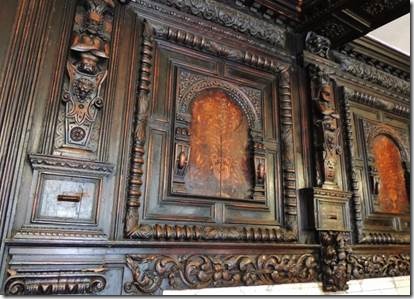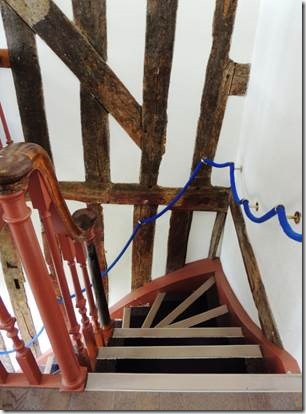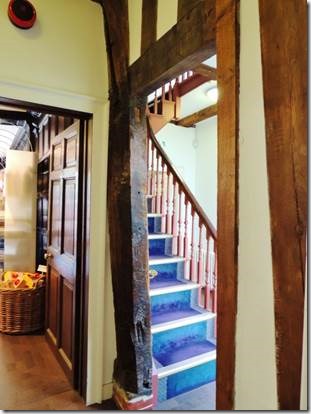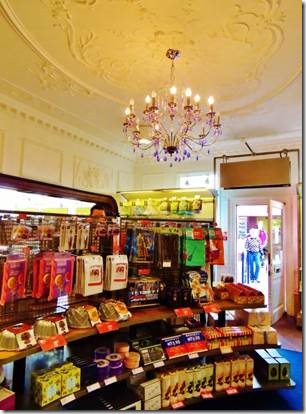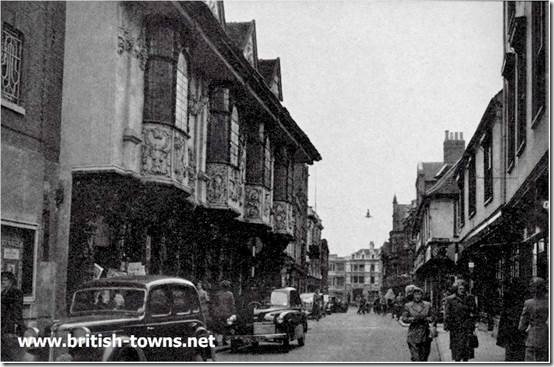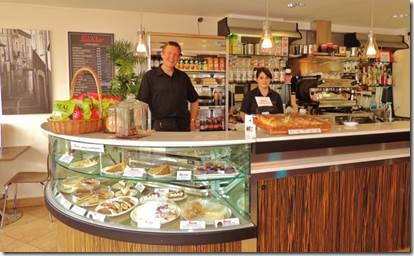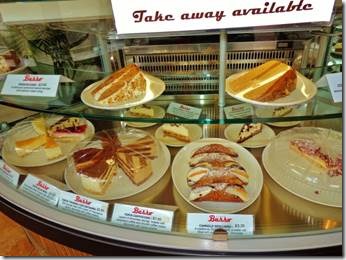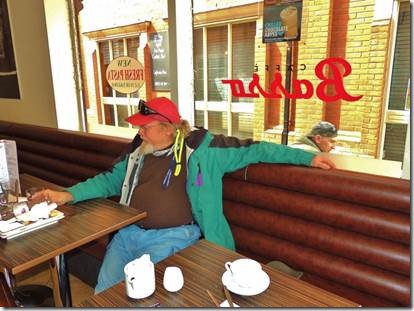Cheers,
Singkey was just here for a long weekend and also new friends Peter and Cathy for a night and lovely day, so I’m pleasantly tired. But I’m getting so far behind on my Ipswich emails that I’m sending this out as is and hopefully most of it makes sense!
Singkey taking her turn in the galley.
Cathy and Peter who live in France and are hoping to become cruisers.
……..
I love the Ipswich Tourist Office!!! Everyone who works there is sooooooo helpful and friendly. It’s great. Reminds me of my days at the Reference Desk watching my “staff” help people. I put “staff” in quote because though I was the “boss” they worked as they did from their own dedication to the job of helping people. Most of them had far more patience and more customer service attitude than I did. All of the tourist office folks here are equally helpful so I have no favorites. But I do have a favorite in Sainsbury’s supermarket. Don’t know her name but she is just great and so warm and cheerful. Some people just are the exact right person for the job or they’ve had super training. But I digress…..
This email is about the building that houses the Tourist Office, the Ancient House building, and a newly discovered eatery, Basso.
Ru
|
The Tourist Office : “Conveniently situated in the Town Centre, in the lovely medieval building of St Stephen’s Church.” “Like all medieval towns, Ipswich entered the last few decades of the 20th century with a surfeit of Anglican churches. This is partly the fault of the Victorians it must be said, who rather overstretched the Church of England with the building of massive new churches in the suburbs, and the enthusiastic restoration of the medieval ones. Unfortunately, their work began to wear out at pretty much the same time as the congregations began to melt away, and in any case Ipswich had been less successful than most towns at encouraging people to live in the town centre. By the 1970s, the population of this parish was probably in single figures. When St Stephen’s church was declared redundant in 1975, it was lost in a sea of rundown shops, overlooked by a redundant factory. It wasn’t a pretty sight. I first visited it in 1987, when it was being used for performances of TS Eliot’s Murder in the Cathedral. It was ideal for this – high, dark, shabby. When the area became the location for the new Buttermarket Shopping Centre, various plans were made to include St Stephen in the complex. All the buildings around it were quickly demolished. And then, the recession set in, and St Stephen stood high and dry for several years, looking rather more prominent than it probably wished to be. The church suffered heavily from vandalism in the early nineties, and several of the great tomb chests in the churchyard were disrupted. But in 1994, St Stephen became the new Tourist Information Centre for Ipswich. It was thoroughly restored inside, its former shabbiness cloaked in brilliant white. All the fixtures and fittings were sensitively showcased, and you still enter the fine west doorway with its flanking niches and stoup, past the font. The fine 16th century roof has been cleaned, the monuments stand out splendidly from the whitewash, and the holy end has been sensitively preserved as an exhibition space, and was for a while still used by the parish of St Mary le Tower on St Stephen’s Day each year. From the outside, the extent to which the church was restored in 1866 and again in 1881 is clear, although it must be said that the brick makes it rather distinguished at this distance, echoing the red-brick tower of St Mary Elms. Internally, this is the most interesting of the six town centre redundant medieval churches. It is one of only two of them to have found a new use, in this case the local council; ironically, it was Ipswich Borough Council who took possession of the redundant churches from the diocese in the first place. The best monument is set on what was the north wall of the chancel. It is to Robert Leman, a one-time Lord Mayor of London, and his wife. They face each other across a prayer desk; mourning them below are one son and five daughters, facing each other across the inscription, which is worth a read, for the couple died on the same day: (my photo) "A rare remark of a conjugal tye" Beneath this monument entombed lie A rare remark of a conjugal tye. Robert and Mary, who to show how neere They did comply, How to each other deere One loathe behind the other long to stay (As Married) Died together in one day. As is common in Ipswich churches, the royal arms are to Charles II. As at St Margaret, they are painted with the Prince of Wales’ fleur-de-lys on the back, and here the board is pleasingly displayed suspended in the chancel arch, so that it is possible to see both sides. They are dated 1661. (I think this is it but I forgot to take thephoto of the other side.) Charles I Prince of Wales As you step back outside, don’t miss the five hatchments around the door, including one very odd square one, and the Victorian glass above the door of the stoning of Stephen. Not sure if this is the odd square one or not but , it looks more oblong to me. But it was the one not set as a diamond shape. (my photo) of the Buttermarket Mall in Arras Square Arras Square is either pleasing or not, depending on your opinion. (They do have a public loo in the mall so that’s nice!) But I think the great glass Festival of Britain frontage of the shopping centre does credit to St Stephen, and the clearing of clutter has unified St Stephen into a line with near neighbours St Lawrence (80m) and St Mary le Tower (160m). The view from the food hall of the shopping centre of the three churches is quintessential Ipswich, if you can bear the seediness of the food hall. It must be said that Arras Square in Ipswich is more pleasant than the Place d’Ipswich in Arras, although the church of St John the Baptist on the square there is well worth a look inside. I do wonder how some of these town twinnings come about; I assume that whoever initiates them gets the best deal. I was struck last year when visiting the beautiful southern French city of Beziers that it is twinned with Stockport – someone in the Greater Manchester area obviously had an eye for the main chance back in the seventies. Arras is no Beziers, but is pleasant enough, if not as grand or interesting as Ipswich. After a period when it looked as though the church might even be lost, St Stephen is the most successful of all attempts to find new uses for Ipswich churches.” |
|
Randal and Singkey in the Tourist office You can see 4 of the hatchments but I have no clue about the 5th so will have to return. A hatchment is “a large tablet, typically diamond-shaped, bearing the coat of arms of someone who has died, displayed in their honor.” I also didn’t notice the stained glass so much so will have to look at that also next visit. |
|
One of the very helpful Tourist Office Staff checking the bus schedule to Pin Mill, a place on the Orwell Randal would like to visit. Everyone in the office is super helpful! They have a huge range of cards and local gifts too. I bought a lovely blue and white Ipswich Tea Towel showing the major landmarks. |
|
How wuz oi spuz t’now? How was I to know is their translation but I think it should be, How was I supposed to know? I love all the “keep calm and carry on” kitsch but the mug I bought Randal didn’t carry on at all. It cracked in a few months. |
|
As I’ve become addicted to “tea towels” I bought the tea towel on theright as we’ve seen all of those places including going under the Orwell Bridge. |
|
The Ancient House…. The Ancient House or Sparrowe House is fascinating outside as well as inside. “Standing on the corner of the Buttermarket & St. Stephen’s Lane, the Ancient house is a grade I listed building dating from the fifteenth century. Built by Thomas Fastolf of Nacton, it was extended by George Copping, who built the ‘long gallery’; having acquired the house in 1567. In 1591 it was taken over by William Sparrowe, who turned it into a grocery & spice shop. The Sparrowe family owned the property for the next three hundred years, hence the building’s alternative name of ‘Sparrowe’s House’. It was the Sparrowe family that added the elaborate wood carving & extensive decorative pargeting (plasterwork) that can be seen today. Legend has it that King Charles II hid in the house after the Battle of Worcester in 1651; the Sparrowes being secret Royalists. However, this seems unlikely, as the King was Catholic & Ipswich at that time was staunchly Puritan. In 1801, however, a secret chapel was discovered in a concealed loft, in which were found wooden angels & other Catholic artifacts. The King did visit Ipswich in 1668, after the Restoration, & his Royal Arms can be seen in the pargeting. Also to be seen are the four known continents (Australasia having not been discovered at the time), the elements earth, air & water, & St.George slaying the dragon. The interior boasts decoration dating from every century from the fifteenth to the twentieth, including elaborate wood carvings, plasterwork & fireplaces. During restoration work, two painted linen wall hangings were discovered depicting the Labours of Hercules; one shows Hercules slaying the Hydra the other his battle with the giant Antaeus. These 4 feet by 8 feet cloths can be dated to the sixteenth century, as they are mentioned in George Copping’s will of 1578. Replicas of these hangings now adorn the walls above the main staircase in the house, whilst the originals are housed in Christchurch Mansion. Throughout most of the twentieth century, the Ancient house was a bookshop. It was acquired by Ipswich Borough Council in 1980 &, after much needed renovation work, is now a Lakeland shop, with a small art gallery also on site.” http://www.planetipswich.com/ipswichengland.htm#640939914 http://ipswich-lettering.org/ancienthouse.html tells the history of the Ancient House “Pargeting (or sometimes pargetting) is a decorative plastering applied to building walls. The term, if not the practice, is particularly associated with the English counties of Suffolk and Essex. In the neighbouring county of Norfolk the term pinking is used.[1] The Ancient House in Ipswich shows a particularly fine example of pargeting, depicting scenes from the ‘four continents’ of the world. When the hall was built in 1670, Australia was yet to be known as a single continent by the Europeans. Pargeting derives from the word ‘parget’, a Middle English term that is probably derived from the Old French ‘pargeter’ / ‘parjeter’, to throw about, or ‘porgeter’, to roughcast a wall. (Source: Webster.) However, the term is more usually applied only to the decoration in relief of the plastering between the studwork on the outside of half-timber houses, or sometimes covering the whole wall. The devices were stamped on the wet plaster. This seems generally to have been done by sticking a number of pins in a board in certain lines or curves, and then pressing on the wet plaster in various directions, so as to form geometrical figures. Sometimes these devices are in relief, and in the time of Elizabeth I of England represent figures, birds and foliages. Fine examples can be seen at Ipswich, Maidstone, Newark-on-Trent.” |
|
In the centre of the frontage between the two pairs of oriel windows is the wonderfully restored crest with mottos. It bears the Royal Arms of King Charles II, and the words: ‘HONI SOIT QUI MAL Y PENSE’ This is old French for "shame upon him who thinks evil of it", and is also the motto of the Order of the Garter. Below on a blue panel is: ‘DIEU ET MON DROIT’ ("God and my right"). At the very top, picked out in gold are the characters: ‘C II R’ |
|
America Africa Asia Europe “It is also worth noting the four panels representing the continents of Africa, Asia, Europe and America. Australasia is conspicuous by its absence as it was yet to be discovered by Europeans.” Ipswich Town Centre Trail pamphlet. FYI – “Australasia, a region of Oceania, comprises Australia, New Zealand, the island of New Guinea, and neighbouring islands in the Pacific Ocean. Charles de Brosses coined the term in Histoire des navigations aux terres australes. “Wikipedia A timber-framed and plastered house. 2 stories and attics with a jettied upper story. There are four fine rounded bay windows on the north front of the first floor and one on the west on St Stephen’s Lane. The panels below the bays measure about one metre in height and two metres in width. The pargetted figures (identified by inscriptions on the panels) represent America – strong archer with bison – Africa with crocodile – then the coat of arms of Charles II. This is followed by Asia, with exotic tall turban and a spear in one hand, and a censer in the other. She sits besides a palm tree in front of a lion and minarets as she rides a camel with a parrot. Finally Europe, framed by a generic tree is crowned holding her sceptre together with an open book and with a cornucopia. She is set in front of a church with spire while riding a very strange animal. The panel on the corner of St Stephen’s lane shows a gentleman approaching a shepherdess with her sheep with Atlas supporting a globe under the bay window. Other decoration shows the Pelican in its Piety feeding its young with its own breast and probably the Phoenix arising form the ashes on the corner with Stephen’s. The gables of the windows are decorated with swags – vases of flowers and putti including one showing them topsy-turvy. The first floor windows are divided by fifteen carved wooden posts Description (iconographical) The key to the decoration is the family’s trade as spice merchants – hence Atlas supporting the globe and the four major continents -their suppliers. Robert Sparrow, responsible for the decoration was a strong supporter of Charles – hence the royal coat of arms and welcome from the shepherdess (Ipswich?) for her gallant gentleman (the return of the Stuarts). Some of the continents were based on Cesare Ripa’s widely available Italian handbook the Iconologia published in Rome in 1603 (332- 338), but only translated into English in 1709. Ripa shows Asia with a Camel, because they use it most, and censer because of spices (but does not mention the lion, palm tree or building). America has been changed from a scantily dressed female with bow and arrow to a man. According to Ripa Europe is richly dressed with a cornucopia to suggest wealth and crowned with a temple, changed to a church to suggest the Anglican faith. Africa here is very different from Ripa. http://www.racns.co.uk/sculptures.asp?action=getsurvey&id=346 |
|
The Interior of the Ancient House is now a Lakeland Kitchenware shop. http://www.lakeland.co.uk/stores/ipswich is the link for the Lakeland Kitchenware, Home and Garden supplies as well as a variety of chocolates and baking supplies. But they keep a small room with photos of the house through the years and some of its history. |
|
John Sparrowe portrait by Thomas Gainsborough |
|
http://www.ancienthouse.co.uk/about/history/ “The association with books goes back a long way, The Ancient House once housed the famous 16th century Town Library (partly based upon a bequest of books by Portman, William Smart), which is currently held by The Ipswich School. The Ancient House Press was established in 1845 as a book-selling and printing business in this historic building. After a period of time the book-selling and printing businesses were separated and the latter moved to larger premises in the town and became the root of the existing company today. It remained there until 1985 when, due to expansion, the company moved to its existing site on the Hadleigh Road Industrial Estate. The Company was started by Mr. Frederick Pawsey, a well-known local figure in printing circles. He sold the business in 1897 to the Harrison family, who retained ownership until 1971 when the present owners took over.” http://ipswich-lettering.org/ancienthouse.html “Ipswich Library before 1924…. Between 1887 and 1924, the library was situated in the museum in High Street. The following is the description for the library given in Kelly’s Directory of Ipswich for the year 1920. Although Kelly’s was primarily a business directory, it had, as its first section, information about the town. As you can see below, these entries were quite extensive. Notice that they call it the "Free Library". This was quite a common description since there often existed a public subscription library at the same time as the publicly-funded library was first formed. Here in Ipswich there was a subscription library that operated from Ancient House.” http://www.suffolklibraryuser.org.uk/page011.htm I actually have a library card from the public library here in Ipswich! |
|
Original Decorative woodwork |
|
Original Stairwell from the Ancient House with its warren of rooms |
|
The Lakeland Shop chandelier on the ground floor entry room; Singkey browsing all of the amazing items available. |
|
Ancient house around 1958 ! Not so really different now except it’s a pedestrian walking area which is really nice. |
|
………. Lunch at Basso, a new eatery we discovered the other day. I had a toasted Brie and cranberry sandwich with just enough good salad greens. Randal and Singkey had sandwiches on baguettes. All were really good and the welcome from the staff made us feel right at home. An elderly “regular” came in and she was made to feel so very welcome. I love places like this. Not that “chains” can’t be local, but these independents are really more fun for us. Don’t the desserts look tempting and we might have to come for the pizza one day. http://fionaroberts.wordpress.com/ is a fun article about chain coffee shops vs these wonderful independents. Makes me definitely want to try the cappuccino. |

